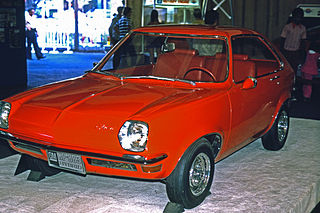
General Motors Company (GM) is an American multinational automotive manufacturing company headquartered in Detroit, Michigan, United States. It was founded by William C. Durant on September 16, 1908, as a holding company, and the present entity was established in 2009 after its restructuring. The company is the largest American automobile manufacturer and one of the world's largest automobile manufacturers.

The Segway is a two-wheeled, self-balancing personal transporter invented by Dean Kamen and brought to market in 2001 as the Segway HT, subsequently as the Segway PT, and manufactured by Segway Inc. HT is an initialism for "human transporter" and PT for "personal transporter."

The Chevrolet Impala is a full-sized car built by Chevrolet for model years 1958 to 1985, 1994 to 1996, and 2000 to 2020. The Impala was Chevrolet's popular flagship passenger car and was among the better-selling American-made automobiles in the United States.

The Cadillac CTS is an executive car that was manufactured and marketed by General Motors from 2003 to 2019 across three generations. Historically, it was priced similarly to cars on the compact luxury spectrum; but it has always been sized closely to its mid-size rivals. The third generation competes directly with the mid-size luxury cars. Initially available only as a 4-door sedan on the GM Sigma platform, GM had offered the second generation CTS in three body styles: 4-door sedan, 2-door coupe, and 5-door sport wagon also using the Sigma platform — and the third generation was offered only as a sedan, using a stretched version of the GM Alpha platform.

The General Motors EV1 was an electric car produced and leased by General Motors from 1996 to 1999. It was the first ever mass-produced and purpose-designed electric vehicle of the modern era from a major automaker and the first GM car designed to be an electric vehicle from the outset.

The Chevrolet Equinox is a series of mid-size, later compact crossover SUV from Chevrolet, introduced in 2004 for the 2005 model year.

A three-wheeler is a vehicle with three wheels. Some are motorized tricycles, which may be legally classed as motorcycles, while others are tricycles without a motor, some of which are human-powered vehicles and animal-powered vehicles.
Hybrid vehicle drive trains transmit power to the driving wheels for hybrid vehicles. A hybrid vehicle has multiple forms of motive power.
Chevrolet Europe GmbH was a subsidiary company of GM Korea, founded in 2005, with headquarters in Zürich, Switzerland. It provided Chevrolet brand automobiles, most of which were made in South Korea for the European market.
General Motors operates several proving grounds.

The Chevrolet Volt is a plug-in hybrid manufactured by General Motors, also marketed in rebadged variants as the Holden Volt in Australia and New Zealand, Buick Velite 5 in China, and with a different fascia as the Vauxhall Ampera in the United Kingdom and as the Opel Ampera in the remainder of Europe. Volt production ended in February 2019.

In the late 1960s, General Motors Company directed its GM R&D and Pontiac divisions to develop concept mini-cars for urban drivers. GM developed the XP-883 an experimental plug-in hybrid car demonstrated by General Motors in 1969. Primarily intended as a commuter vehicle, the very small car had a fiberglass body with a design resembling the future Chevrolet Vega or Ford Pinto. The two-door hatchback had seating for two adults and two children, though the children sat in rear-facing seats and would enter and exit through the tailgate. It was powered by the combination of a two-cylinder engine and a DC electric motor. Electricity was stored in six 12-volt batteries placed between the rear wheels. The related Pontiac concept was the Pontiac X-4 with a radical two stroke aircraft type radial engine.

The General Motors Precept was a 2000 low emission vehicle concept car aimed at meeting the 80 mpg‑US fuel economy goal of the Partnership for a New Generation of Vehicles between the US Government and GM, Ford, and Chrysler. GM was able to meet the 80 mpg‑US fuel economy goal with the Precept, creating versions using Lithium and NiMH batteries with diesel, fuel cell and other hybrid version of the car.

The Cadillac ELR is a two-door, four-passenger luxury plug-in hybrid compact coupé manufactured and marketed by Cadillac for model years (MY) 2014 and 2016 – with a hiatus for MY 2015. Using a retuned version of the Chevrolet Volt's Voltec EREV drivetrain, the ELR's lithium-ion battery pack delivers an all-electric range of 37–39 miles (60–63 km) and a top speed of 106 mph (171 km/h).

General Motors EN-V is a 2-seat urban electric concept car jointly developed by Segway Inc. and General Motors that can be driven normally or operated autonomously.

Segway Inc. is an American manufacturer of two-wheeled personal transporters, chiefly through its Segway PT and Segway miniPro product lines. Founded by inventor Dean Kamen in 1999, the company's name is a homophone of the word "segue".

The Cadillac Urban Luxury Concept (ULC) is a gasoline-electric hybrid, 4-seater, city concept car from Cadillac unveiled at the 2010 Los Angeles Auto Show. The vehicle features touchpad screens and projected displays that take the place of traditional gauges.
The Scaled Composites Model 367 BiPod is an experimental flying car developed by Scaled Composites. It was the final aircraft designed by Burt Rutan prior to his retirement.

A personal transporter is a class of compact, mostly recent, motorised micromobility vehicle for transporting an individual at speeds that do not normally exceed 25 km/h (16 mph). They include electric skateboards, kick scooters, self-balancing unicycles and Segways, as well as gasoline-fueled motorised scooters or skateboards, typically using two-stroke engines of less than 49 cc (3.0 cu in) displacement. Many newer versions use recent advances in vehicle battery and motor-control technologies. They are growing in popularity, and legislators are in the process of determining how these devices should be classified, regulated and accommodated during a period of rapid innovation.















